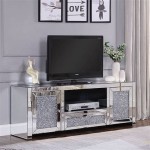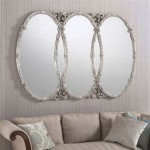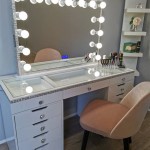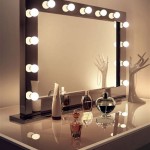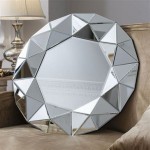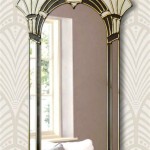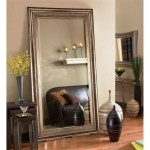How To Hang A Framed Mirror
Hanging a framed mirror correctly involves several key steps to ensure both safety and aesthetic appeal. Careful planning and execution will result in a securely mounted mirror that enhances the room's décor.
Assessment and Planning: Begin by assessing the wall where the mirror will be hung. Consider the wall's material (drywall, plaster, concrete, etc.) as this determines the appropriate hanging hardware. Locate wall studs using a stud finder for optimal support, especially for heavier mirrors. Mark the desired location of the mirror on the wall with a pencil.
Choosing the Right Hardware: The weight and size of the mirror dictate the type of hardware required. For lighter mirrors, D-rings and picture wire are often sufficient. Heavier mirrors may require more robust hardware, such as heavy-duty D-rings, wire, and wall anchors rated for the mirror's weight. Consult the packaging of the chosen hardware for weight limits and follow the manufacturer's instructions.
Preparing the Mirror: If the mirror doesn't already have D-rings attached, these need to be installed. Measure and mark the placement of the D-rings on the back of the frame, ensuring they are evenly spaced and level. Screw the D-rings securely into the frame. The placement of the D-rings will determine the hanging height of the mirror. Take into account the distance from the top of the frame to the wire once attached.
Attaching the Wire: Cut a length of picture wire slightly longer than the width of the frame. Thread the wire through one D-ring, wrapping it around itself several times to secure it. Repeat this process with the other D-ring, pulling the wire taut. The wire should create a gentle inverted V-shape when the mirror is lifted.
Selecting the Wall Fasteners: The appropriate wall fasteners depend on the wall material and the weight of the mirror. For lighter mirrors on drywall, picture hooks are often adequate. Heavier mirrors require wall anchors appropriate for the wall type and the weight being supported. Consult the packaging of the wall anchors for weight limits.
Marking and Installing the Wall Fasteners: Measure the distance between the top of the frame and the wire when the wire is taut. This measurement determines the placement of the wall fastener. Hold the mirror against the wall in the desired position and mark the location of the wire on the wall. Measure down from this mark the distance previously measured between the frame top and the wire. This is the point where the wall fastener should be installed.
Hanging the Mirror: Carefully lift the mirror and hang the wire onto the installed wall fastener. Ensure the wire is securely seated on the hook or anchor. Step back and check that the mirror is level. Adjust the position as needed by gently shifting the wire on the hook or anchor.
Using a French Cleat: For heavier mirrors, a French cleat provides a more secure hanging method. A French cleat consists of two interlocking pieces of wood, one attached to the wall and the other to the back of the mirror frame. The angled design of the cleat creates a strong, flush mount.
Installing a French Cleat: Attach one part of the cleat to the wall, ensuring it is securely fastened to studs or using appropriate wall anchors. Attach the other part of the cleat to the back of the mirror frame, aligning it with the wall cleat. Carefully lift the mirror and interlock the two cleats, ensuring a tight fit.
Safety Precautions: Always use appropriate safety measures when hanging mirrors. Wear safety glasses to protect eyes from dust and debris. Use a level to ensure the mirror hangs straight. For very heavy mirrors, enlist the assistance of another person.
Alternative Hanging Methods: Adhesive hangers designed specifically for mirrors offer a no-drill option for lighter mirrors. These hangers use a strong adhesive to attach to the wall and the back of the mirror. Ensure the wall surface is clean and smooth for proper adhesion. Always follow the manufacturer's instructions for weight limits and application.
Considerations for Specific Wall Types: Different wall types require different approaches. For plaster walls, ensure the wall anchors are suitable for plaster. For concrete walls, use concrete screws or anchors designed for concrete. For brick walls, use brick anchors or screws specifically designed for brick.
Dealing with Irregularly Shaped Mirrors: Hanging irregularly shaped mirrors presents unique challenges. Careful planning and precise measurements are essential. Consider using multiple hanging points or a combination of hanging hardware to ensure stability. For very large or unusually shaped mirrors, consult a professional for installation.
How To Hang A 100 Pound Mirror On Drywall Quora

How To Hang A Large Or Heavy Mirror

How To Hang A Large Wall Mirror Step By Tutorial

How To Hang A Frameless Mirror On The Wall With Pictures

How To Hang A Heavy Mirror Diy Family Handyman

How To Hang A Heavy Mirror With Pictures Wikihow

How To Hang A Mirror Home

How To Hang A Heavy Mirror C R F T

How To Hang A Heavy Mirror The Home Depot

How To Hang A Heavy Mirror C R F T

